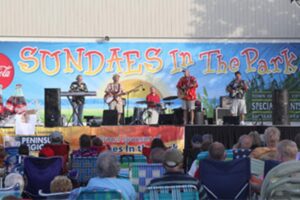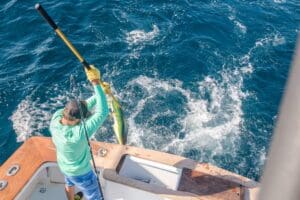Surfin’ O.C.
The History of Surfing in Ocean City
People have been riding waves for thousands of years. Surfing, as we’ve come to know it, has a long history and strong culture that varies across the world. In Ocean City, the evolution of surfing has transformed over almost a century.
A trip to the Ocean City Life-Saving Station Museum will transport you through time as you learn about Ocean City’s past. Celebrate the history of surfing in this coastal community by exploring the Surfs Up! – Riding the Waves of Change exhibit at the museum.
According to the exhibit, the Fennimore, Baker and Fox families from Baltimore visited Ocean City in 1906 and began body surfing. It wasn’t until the 1920s that local George Bert Cropper built the first surfboard in Ocean City. Cropper, along with his brothers Harry and Bob, surfed these East Coast waves much like iconic surfer Duke “The Big Kahuna” Kahanamoku did on the West Coast.
Many other locals can be attributed for introducing surfing to Ocean City. The Surfs Up! exhibit features a letter to the editor of The Sunday Sun that states 20-year-old Watts Smith, who became an expert surfer while living in Hawaii, traveled to Ocean City in the 1920s and taught locals how to surf.
When surfing first took off in Ocean City, there weren’t any surf shops. So, surfers attempted to design and build their own boards by hand. Locals built their surfboards from woods like mahogany and pine, then decorated them with a unique design. These handcrafted surfboards were designed to closely resemble those popularized by Hawaiian surf culture.
Surfing’s following skyrocketed in coastal cities across the country in the 1960s, as The Beach Boys introduced America to “Surfing USA.” In 1964, Ocean City’s first surf shop, Eastern Surfer, opened in the basement of The Sandy Hill Motel on 18th Street. The business, owned by Bill Wise and George Pittman, eventually expanded to three locations in Ocean City. Wise and Pittman even refigured an old school bus to rent surfboards out on 93rd Street, which is still a popular surfing area to this day. Eastern Surfer sold Hobie surfboards, one of the leading boardmaking companies from the late 1950s to early 1970s. This provided Ocean City surfers access to some of the highest quality boards available on the East Coast.

Today, it’s easy to buy a mass-produced surfboard from anywhere, but to truly embrace the spirit of the sport, visit a local surf shop. Shapers can build boards to fit your surf soul and personality. These boards are produced at a higher level and can withstand the waves as you practice the sport.
In 1964, the documentary “The Endless Summer” was released. The film created a “surf-and-travel” culture, encouraging surfers to explore new oceans in search of the perfect wave. Despite the sport’s growth in popularity, not everyone in Ocean City embraced the surfing culture and lifestyle. Surfers were generally looked at as “hippies” and unproductive members of society, creating some tension between them and city officials and local business owners.
The Surfs Up! exhibit tells stories about the strife between surfers and city officials. During the spring of 1976, the conflict between the two groups inspired local attorney and surfer Richard Parolski to become the spokesperson for Ocean City’s surfers. As the northern part of Ocean City expanded and saw an increase in development, prime surfing areas began to vanish. Parolski, along with liaison and city councilman Harold “Chip” Gordy, worked to make Ocean City a more “surfer-friendly” town.
While Ocean City is not widely seen as a “surfing town,” there has been more leniency from the Town of Ocean City to maintain the surfing community. With the help of the town’s Surfing Beach Committee and organizations like the Ocean City Surf Club, Ocean City surfers are gaining more accommodations.
During peak beach season (between Memorial Day and Labor Day), Ocean City has two rotating surf beaches seven days a week, and a third beach on the inlet open Monday–Friday. Established by the Surfing Beach Committee, these areas are specifically for surfing.
So, take to one of these surfing beaches and ride the waves this summer to pay homage to Ocean City’s surfing history and heritage.





















